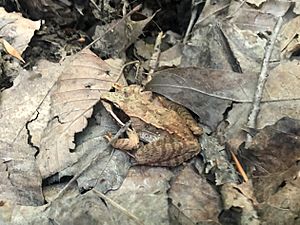Wood frog facts for kids
Quick facts for kids Wood frog |
|
|---|---|
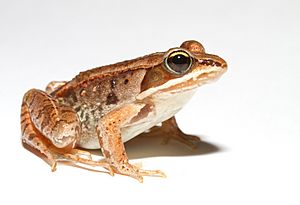 |
|
| Conservation status | |
| Scientific classification | |
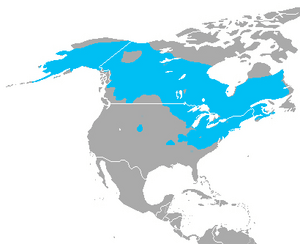 |
|
| Geographic range of the wood frog in North America (in blue) | |
| Synonyms | |
|
Lithobates sylvaticus or Rana sylvatica, commonly known as the wood frog, is a frog species that has a broad distribution over North America.
Contents
Description
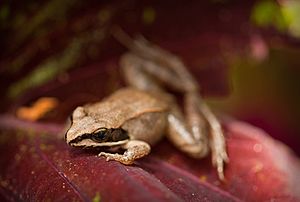
Wood frogs range from 51 to 70 mm (2.0 to 2.8 in) in length. Females are larger than males. Adult wood frogs are usually brown, tan, or rust-colored, and usually have a dark eye mask. Individual frogs are capable of varying their color; Conant (1958) depicts one individual when light brown and dark brown at different times. The underparts of wood frogs are pale with a yellow or green cast; in northern populations, belly may be faintly mottled. Body colour may change seasonally; exposure to sunlight causes darkening.
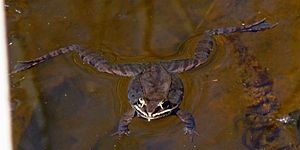
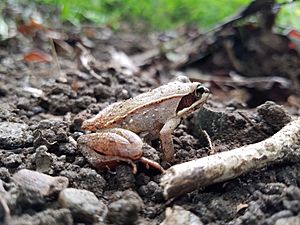
Geographic range
The contiguous wood frog range is from northern Georgia and northeastern Canada in the east to Alaska and southern British Columbia in the west. It is the most widely distributed frog in Alaska. It is also found in the Medicine Bow National Forest.
Habitat
- Prefers moist woodland areas, bogs, and marshes, but can also be found in tundra and grasslands.
- Requires temporary or permanent bodies of water (like ponds or vernal pools) for breeding.
Adaptations
- Freeze Tolerance: The wood frog is famous for its ability to survive freezing during winter.
- Camouflage: Its coloration helps it blend into leaf litter and forest floors, providing protection from predators.
Behavior and Life Cycle
Breeding
Breeding occurs in early spring, often in temporary pools or ponds formed by melting snow. Males call to attract females with a distinctive quacking or chuckling sound. Females lay egg masses containing hundreds of eggs, which hatch into tadpoles within a few weeks.
Feeding
The feeding pattern of the wood frog is basically similar to that of other ranids. It is triggered by prey movement and consists of a bodily lunge that terminates with the mouth opening and an extension of the tongue onto the prey. The ranid tongue is attached to the floor of the mouth near the tip of the jaw, and when the mouth is closed, the tongue lies flat, extended posteriorly from its point of attachment.
In the feeding strike, the tongue is swung forward as though on a hinge, so some portion of the normally dorsal and posterior tongue surface makes contact with the prey. At this point in the feeding strike, the wood frog differs markedly from more aquatic Lithobates species, such as the green frog, leopard frog, and bullfrog. The wood frog makes contact with the prey with just the tip of its tongue, much like a toad. A more extensive amount of tongue surface is applied in the feeding strikes of these other frog species, with the result that usually the prey is engulfed by the fleshy tongue and considerable tongue surface contacts the surrounding substrate.
Diet
Adults feed on insects, spiders, worms, and other small invertebrates. Tadpoles are herbivorous, feeding on algae and plant matter.
Hibernation
Wood frogs hibernate during winter, often under leaf litter or soil. Their ability to freeze and thaw allows them to survive in harsh climates where other amphibians cannot.
Ecological Importance
Wood frogs play a vital role in their ecosystems as both predators and prey. They help control insect populations and serve as food for birds, snakes, and small mammals. Their sensitivity to environmental changes makes them an indicator species for ecosystem health.
Conservation Status
Wood frogs are currently listed as Least Concern by the IUCN due to their wide distribution and stable populations. However, habitat loss, pollution, and climate change pose potential threats to their survival.
Interesting facts about the wood frog
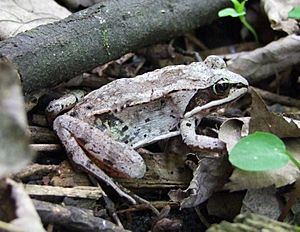
- Frogs found in southern Canada and the American midwest can tolerate freezing temperature of -3 to -6 °C.
- Up to 65% of its body water can freeze, and its heart and breathing stop. It achieves this by producing high concentrations of glucose, which acts as a natural antifreeze, protecting its cells from damage.
- Wood frogs are mostly diurnal and are rarely seen at night.
- They are one of the first amphibians to emerge for breeding right when the snow melts, along with spring peepers.
- The wood frog has been proposed to be the official state amphibian of New York.
See also
 In Spanish: Rana de bosque para niños
In Spanish: Rana de bosque para niños



